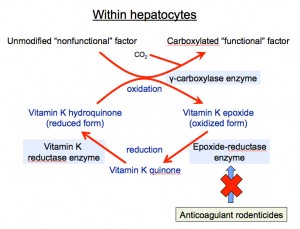When coagulation factors are synthesized in the liver, they are non-functional. They need to be modified (by gamma-carboxylation of glutamic acid residues in the N-termini) to become functional, i.e. capable of binding calcium and phospholipid membranes. The enzyme that does this modified, gamma-carboxylase, also oxidizes vitamin K (reduced or hydroquinone form) at the same time as it is adding carbon dioxide to the factors to modify or carboxylase them.
Vitamin K epoxide (oxidized form) must be recycled back to its reduced form to work in the carboxylation reaction. This is accomplished by two enzymes, one of which – vitamin K epoxide reductase – is inhibited by anticoagulant rodenticides as shown above.
Lack of vitamin K or absence of cycling of vitamin K (from oxidized to reduced forms) due to inhibition by rodenticides prevents modification and functionalzation of the vitamin K-dependent factors. The inactive factors increase in the circulation and are called Proteins Induced by Vitamin K Antagonism or Absence (or PIVKAs). The animal therefore lacks functional coagulation factors (II, VII, IX, X), resulting in prolonged PT and aPTT and clinical hemorrhage.

